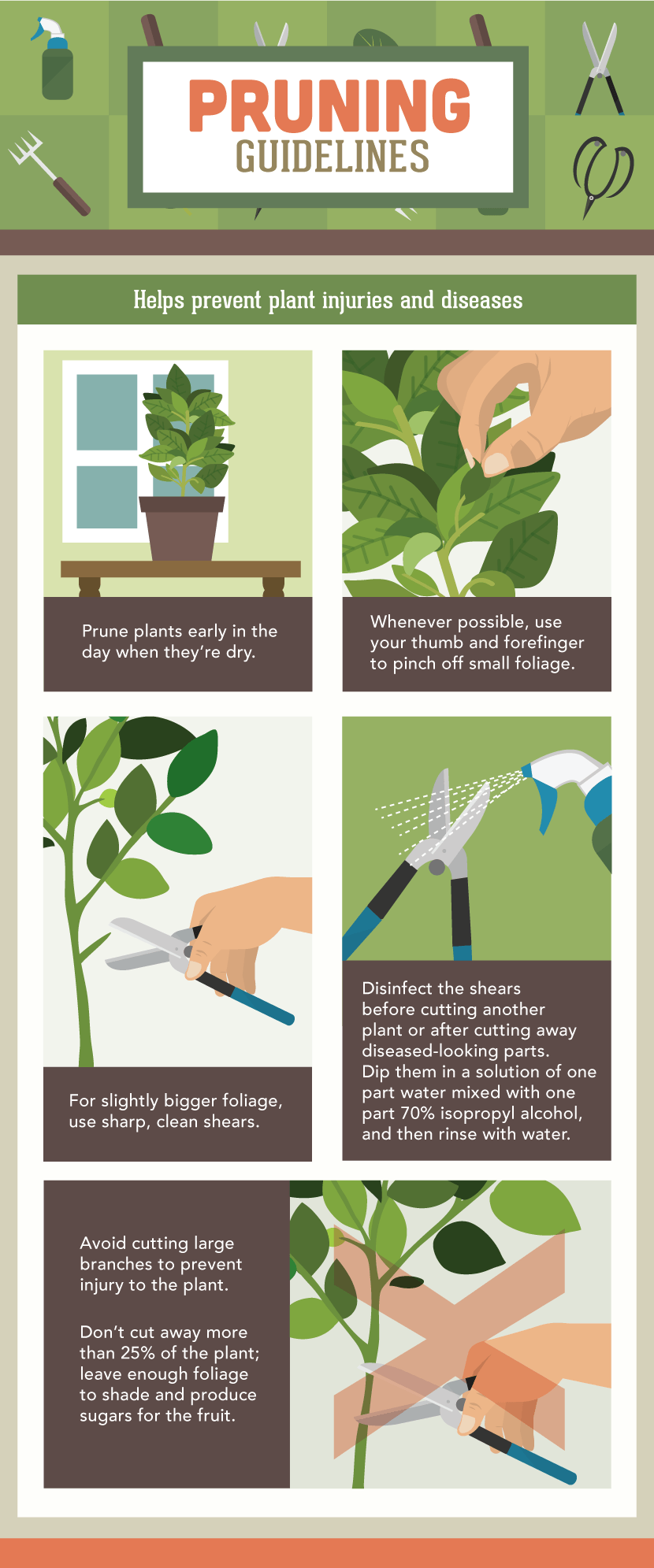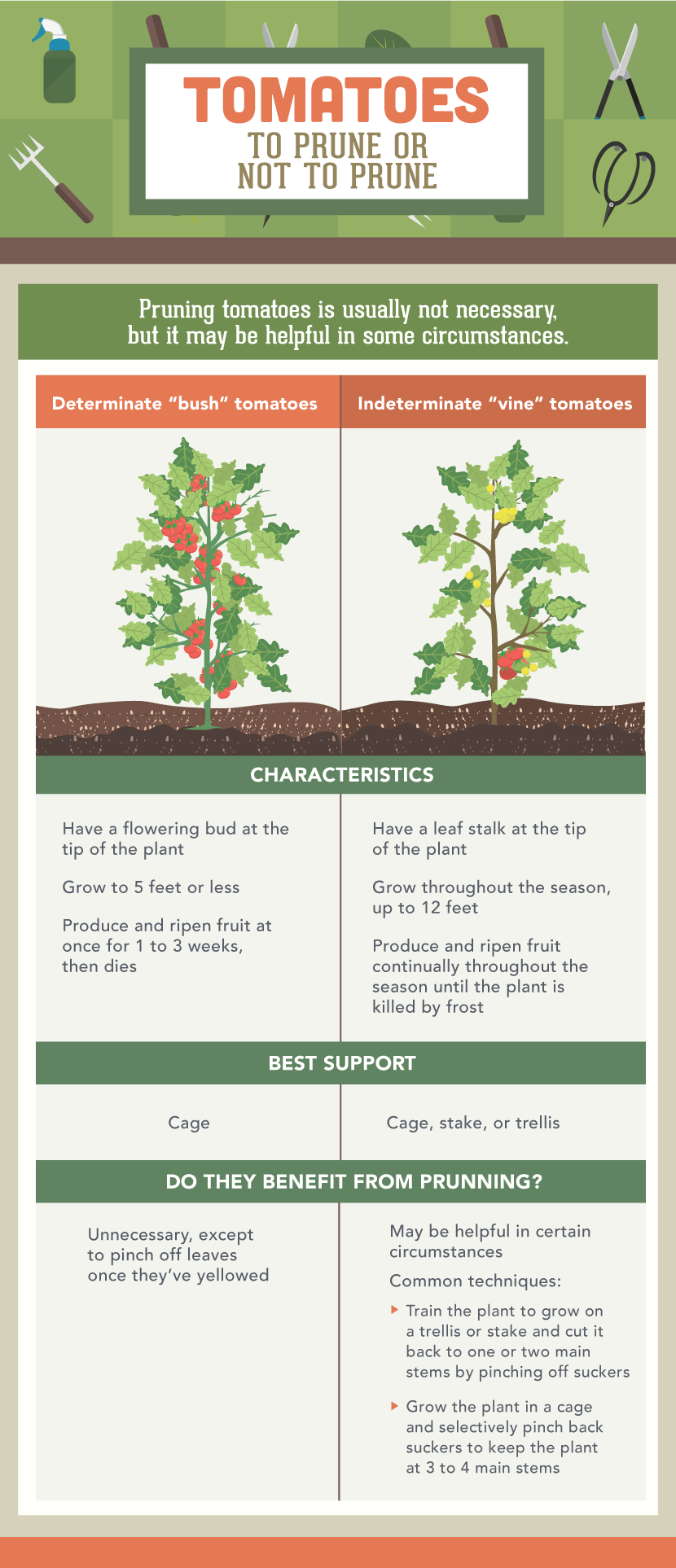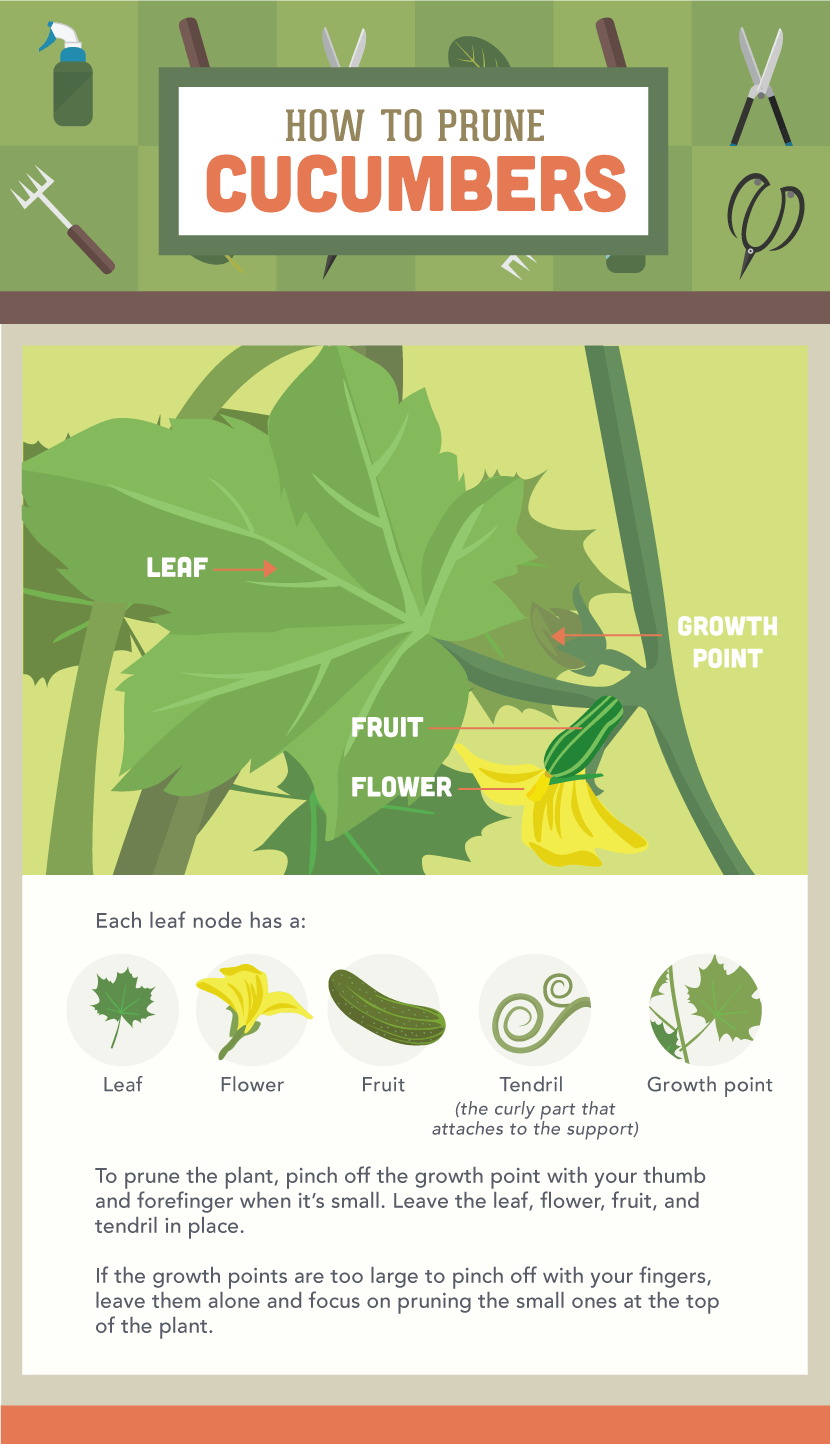Cut to Size:
Vegetable Garden Pruning for Beginners
Vegetable gardens are usually serene places, but the discussions on some gardening forums can get heated. That’s especially true when the topic is vegetable pruning.
Some growers are convinced that selectively snipping tomato, squash, pepper, and cucumber plants increases yields and makes the vegetables bigger and tastier.
Others argue pruning vegetable plants is a waste of time, or worse: It can injure plants, leave fruit exposed to too much sun, and decrease yields.
What’s a gardener to do? Here’s the bottom line: Pruning veggies usually isn’t necessary, but it may be helpful in certain circumstances. Read on to learn about the pros and cons of pruning different vegetables, and the best ways to prune.
A Primer on Pruning
Pruning is a horticultural practice where a gardener selectively removes parts of a plant –usually the branches, buds, or roots.
It’s done to improve air circulation, train a plant to grow a certain way, improve the yield and quality of flowers and fruit, or remove dead or damaged sections.
Nearly all experts agree it’s a good idea to prune certain plants, including fruit and ornamental trees that lose their leaves in the winter, shrubs, roses, perennial flowers, and grapevines.
Did you notice veggies aren’t on that list? That’s because the jury is still out on this question.
It’s a good idea to remove yellowed leaves or diseased looking parts of vegetable plants. But beyond that, pruning has pros and cons. To understand the topic better, it’s best to look at the commonly pruned veggies on a case-by-case basis.

Tomatoes
Tomatoes are usually front and center in pruning debates. Determinate, or “bush,” tomatoes only produce a set amount of fruit, which ripen all at once during a one- to three- week period.
Most experts agree pruning them is not necessary and will likely decrease fruit yields. (Not sure which kind of tomatoes you planted? Check the seed packet or plant description.)
Indeterminate, or “vine,” tomatoes grow and produce fruit throughout the season, and opinions vary widely about whether or not they should be pruned.
Fortunately, scientists have studied the effects of pruning on indeterminate tomatoes, so there’s some data to help make an educated decision.
Here’s what various studies indicate:
The data should be evaluated with a caveat, though. The tomato plants in these studies were grown for market in fields and hydroponics systems. However, the home garden is a much different ecosystem. You may or may not see the same results in your garden.

With mixed results in studies and the absence of consensus among experts, gardeners have to decide for themselves whether to prune tomato plants. If you’re growing indeterminate tomatoes and training them to a stake or trellis, it makes sense to prune.
Here’s the method of staking and pruning recommended by the experts at Cornell University:
- Soon after transplanting, drive a wooden tomato stake eight to 10 inches into the ground, about two feet away from the plant.
- Prune the tomatoes to one or two stems by pinching off the suckers, which are the stems growing at a 45-degree angle from where the leaf stems meet the main stem, when they are about two to four inches long.
- Tie the main stem(s) to the stake with soft string, forming a figure eight with the stem in one loop and the stake in the other. Start about 8 to 12 inches above the ground and continue to tie at similar intervals as the plant grows.http://www.gardening.cornell.edu/homegardening/sceneea10.html
Some gardeners prune indeterminate tomatoes in cages as well.
This practice usually isn’t necessary, but it makes sense if the plants are outgrowing their cages or if the leaves show signs of leaf spot or another fungal disease that could be remedied by providing more air circulation.
If you decide to prune, the safest way is to use your thumb and forefinger to selectively remove some suckers. You can use a method called simple pruning where you remove the entire sucker, or a method called Missouri pruning where you remove just the tip of the sucker.http://www.tomatodirt.com/pruning-tomato-plants.html
Missouri pruning leaves more foliage, which is advantageous in hot, sunny conditions, because leaf cover shades the fruit and prevents sun scalding.
You can also experiment with additional pruning techniques if you wish. Some gardeners trim the side stems off the lowest 12 to 18 inches of the plant.
Others cut the tops off the main stems four weeks before the expected frost date so the plant can dedicate more resources to ripening fruit.
It doesn’t hurt to try pruning methods if you’d like to grow larger fruit. But be cautious about pruning too much. Plant foliage is there because it serves a purpose.
If you decide to prune your indeterminate tomatoes, heed the popular advice to avoid pruning leaves directly above and below a flower cluster: The leaves above shade the ripening fruit, and the leaves below send sugars to it.https://bonnieplants.com/library/how-to-prune-tomatoes/
Cucumbers
Commercial farmers prune greenhouse cucumbers to one main stem because space is limited and diseases are more common in greenhouses. However, cucumbers grown outdoors in home gardens usually don’t require pruning.
One study suggests pruning can decrease overall cucumber yields.http://www.jpep.ir/browse.php?a_id=47&slc_lang=en&sid=1&printcase=1&hbnr=1&hmb=1
However, if you have a compact garden and want to save space, follow the pruning method used by commercial growers.

When growing cucumbers in a cage, some gardeners also cut the growing tip off the plant when the cucumber reaches the top of the cage.http://www.harvesttotable.com/2011/05/cucumber_growing_tips/
In addition, because the leaves are commonly afflicted with powdery mildew, cucumbers may need pruning for disease prevention.
If you see white or gray spots on leaves, trim them off with sterilized shears and discard in a trash can or yard waste bin to prevent the spread of the fungus.
Squash
Squash don’t usually require pruning except to harvest flowers or remove dead or diseased blossoms and leaves. (As with cucumbers, they’re often afflicted with powdery mildew.)
But you may want to cut them back for space reasons because they spread. It usually doesn’t harm the plant to prune if needed.
To prune winter squash, let the plant grow until it develops three to five fruits, then use sharp, clean shears to cut the end of the vine two leaf nodes after the last fruit.http://www.hortmag.com/plants/fruits-veggies/can-i-prune-a-squash-vine For summer squash, use sharp shears to cut the plant back to four main stems.
When possible, leave the female flowers in place and prune the male flowers, leaving a few behind for fertilization.http://homeguides.sfgate.com/prune-summer-squash-67251.html

If you’re gardening in a small space, it’s possible to grow summer squash on a stake. Emily at My Square Foot Garden recommends driving a four-inch stake into the ground next to the plant at planting time.
Then as the summer squash grows and produces fruit, cut all the leaves between the fruit and the ground, and tie the vine to the stake.http://www.mysquarefootgarden.net/pruning-zucchini/
Peppers
Commercial growers often prune bell peppers so they can be grown on trellises in greenhouses. While the practice is not necessary or common in the home garden, many gardeners swear by pruning hot peppers.http://www.johnnyseeds.com/assets/information/peppers-bell-greenhouse-production-8853.pdf
The optimal time to do it is three to five weeks after germination, several weeks before the plants are hardened off and transplanted outdoors. Advocates say the practice creates bushier, hardier plants and produces bigger yields.
Here’s a common technique:
- Wait until the plant is producing flowers, or is at least six inches tall.
- Start at the bottom of the plant and count the sets of leaves going up.
- Find the third set of leaves, and cut the main stem of the plant about 1/4 inch above it.
- Allow the plant to grow as normal.
- In addition, some gardeners pinch off the flowers until the plant is transplanted outdoors, and some pinch off suckers at the end of the season to encourage the plant to put more energy into pepper production and ripening.https://www.youtube.com/watch?annotation_id=annotation_3185099117&feature=iv&src_vid=BJ5PEFFo88I&v=ljFSZKyShV8
Joe of Cragfire Gardening conducted his own experiment to compare the yields of three cayenne plants pruned with the above method with three of the same plants left unpruned. He treated the plants the same except for pruning.
In the end, the unpruned plants produced two more peppers than the pruned plants, but the harvest from the pruned plants weighed slightly more than the harvest from the unpruned plants. Joe concluded it was a statistical tie.https://www.youtube.com/watch?v=ZJtart2yOZ0
Let Your Garden Be Your Laboratory
Don’t be afraid to conduct your own experiments. Your garden is the best teacher. Prune a few of your veggies, observe what happens, and let experience be your guide.
Embed the article on your site

